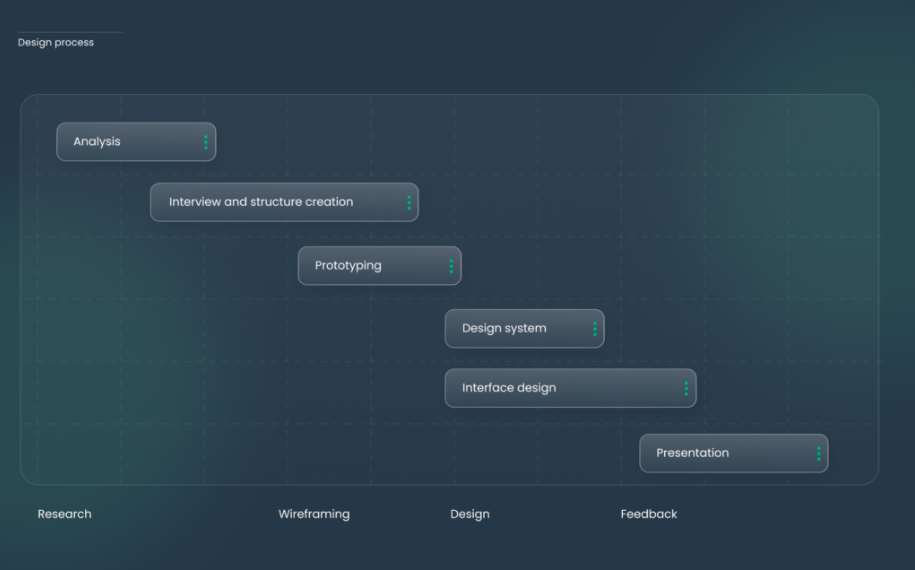With 3.5 billion fans worldwide and 250 million players across 200 countries around the world, football is the true king of all sports. This is not just a game, but a worldwide phenomenon. It connects every country, group, and nationality.
There are a lot of products dedicated to football and related sport activities. Most of them were made for fans and athletes, but what do strategy-focus people care about?
The Pecode team has developed various web and mobile apps since 2017. Throughout the years we were working on projects in over ten different industries. Of course, every project has its own story.
Today, we want to share our newest case study. Let us tell you how we managed to create a niche social media platform — Gaffer.
Challenge
So, basically, what is Gaffer?
Our goal was to create a user-friendly and well-operable web platform for football coaches. It needed to be a place where coaches from all around the world can share, discuss, and create their own drills.

Analysis and preparation
Before diving into building visual identity and app logic, our team conducted a deep analysis of Gaffer’s opportunities. The main focus of our research was defining the needs and wishes of our target audience. The discovery of these factors allowed us to implement relevant functionality and visual identity.
We started interviewing football coaches and asking questions on their forums. The results were worth investing the time and effort.
Key insights:
1) Most of the coaches outlined that they use their mobile phones or notebooks primarily. As they say, when you see a new possibility to improve your strategy, you need to write that down as soon as possible. Otherwise, you will forget it within minutes.
2) The problem was not in making notes, but in searching for inspiration. The information you can find on forums isn’t well-organized and is often displayed in different form. We needed to improve on this.
3) The vast majority of coaches pointed out that they often try to mix their strategies with other examples from other coaches. This is a exercise, which helps you find more opportunities faster.
After finding all necessary information about customers’ needs, we moved to design.

,
Design and wireframing
In order to ensure compliance with the users’ needs, we based the whole design process on Design Thinking methodology. Therefore, the design process was divided into 6 stages: Analysis, Interview, Prototyping, Design System, Interface Design, Presentation. Two of them we already completed..

The first thing we did was make a detailed User Flow Map. This map helped us to understand the future journey of our users, so we started wireframing main screens.

Along with wireframing, we created branded materials and established brand guidelines. These were, fonts, colors, rules of usage of branded elements, a logo. Everything was designed to represent the training camp atmosphere.

And of course, the design system.

As a whole, the Pecode design team successfully finished all necessary design stages. The next phase was development.,
Development
We planned Gaffer as a Web Application. However, it has responsive design adapted for mobile and tablet usage.
The functionality of Gaffer includes:
– Ability to create a user profile using your email, and log in to a previously created profile.
– By logging in, the user has the opportunity to create posts and publish them in his profile.
– Ability to delete your profile (also change personal data, password, and access for premium access)
– Built-in messenger, in which the user can create chats with other users, as well as create group chats with them.
– Notifications (comments, messages, likes etc.)

After buying a premium subscription, Gaffer opens new opportunities to grow your strategy skills. You will be able to use the editor feature for creating football tactics (drills). The user can choose one of the proposed layouts of the football field, of which he can later place various figures. Those figures are the same as the ones that coaches use on a football pitch. It is also possible to change the size of these figures on the field, rotate them, change their color and move them around the field. All drills created by the user are stored on the “Coaching Center” page, and when creating a new post, it is possible to attach an image of a drill from your profile.
During the development process, we were sticking to SCRUM methodology with the possibility of fully remote work. You can find the principles of effective remote workflow which we use in our team here.
QA
To ensure Gaffer’s good performance, we needed to conduct a full-scale QA analysis and report all possible bugs and pitfalls.
Our QA team took the challenge and accomplished lots of important tasks, including:
– Smoke testing after the implementation of each functionality
– Functional testing of the platform
– Usability testing
– UI/UX testing
– Creation of proposals for new functionality
– Retest and Regression testing
– Security testing
– Database testing
– Responsive testing
– Cross browser testing
– Component, Integration and System testing
– Applied Positive and Negative test scenario
– Applied Use Cases (for different types of users: those with and without searches)
– The deep analysis and custom QA strategy helped us to release Gaffer as a bug-free and smooth platform.

,
Conclusion
Now, Gaffer is a well-optimized web platform available everywhere! You can check it out here.
We are still working with Gaffer to ensure a proper work of the platform and assist with the new updates and features releases.
We believe that the solution we provided will help football coaches from all around the world to improve their skills and make their jobs easier.
Now, we are open to new opportunities, and we will gladly bring your product to a higher level. Contact us via hello@pecodesoftware.com for more information.





